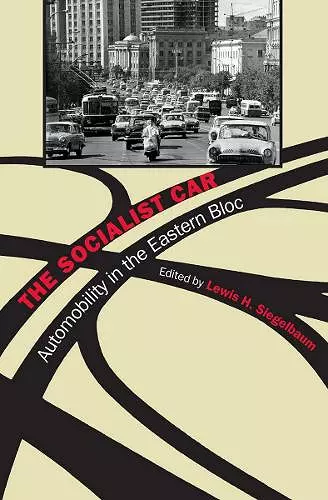The Socialist Car
Automobility in the Eastern Bloc
Format:Paperback
Publisher:Cornell University Press
Published:15th Oct '11
Currently unavailable, and unfortunately no date known when it will be back

Across the Soviet Bloc, from the 1960s until the collapse of communism, the automobile exemplified the tension between the ideological imperatives of political authorities and the aspirations of ordinary citizens. For the latter, the automobile was the ticket to personal freedom and a piece of the imagined consumer paradise of the West. For the authorities, the personal car was a private, mobile space that challenged the most basic assumptions of the collectivity. The "socialist car"—and the car culture that built up around it—was the result of an always unstable compromise between official ideology, available resources, and the desires of an increasingly restless citizenry. In The Socialist Car, eleven scholars from Europe and North America explore in vivid detail the interface between the motorcar and the state socialist countries of Eastern Europe, including the USSR.
In addition to the metal, glass, upholstery, and plastic from which the Ladas, Dacias, Trabants, and other still extant but aging models were fabricated, the socialist car embodied East Europeans' longings and compromises, hopes and disappointments. The socialist car represented both aspirations of overcoming the technological gap between the capitalist first and socialist second worlds and dreams of enhancing personal mobility and status. Certain features of automobility—shortages and privileges, waiting lists and lack of readily available credit, the inadequacy of streets and highways—prevailed across the Soviet Bloc. In this collective history, the authors put aside both ridicule and nostalgia in the interest of trying to understand the socialist car in its own context.
[These] essays are of a high standard and together provide us with an excellent resource for car cultures under twentieth-century socialist regimes.... [They] would make an excellent addition to any reading list concerned with modern Eastern Europe, material culture, and automobility.
- Zachary Doleshal (H-German)As is clear from the eleven chapters covering more than six countries, there was no single consensus on how to reconcile consumers' desires for individual mobility with the ideological demands of collectivity... Together, the essays in this volume both explain and complicate commonly held notions about the deficiencies of consumer goods in the Eastern Bloc. The Socialist Car fills a noticeable gap in comparative studies of consumer culture as well as automobility, and will be of interest to scholars well beyond historians of Eastern Europe.
- Sally West (Canadian-American Slavic Studies)Cars offer a fascinating prism through which to explore the socialist society that materialized in the Eastern Bloc after 1917.... The sociological and cultural approaches one might take in regard to the automobile are numerous and diverse and The Socialist Car does not disappoint.
- Tim Harte (Slavic and East European Journal)In this exemplary volume, the seemingly narrow topic of automobility in the Eastern Bloc becomes a window into aspects of history as varied as factory production, Communist Party politics, urban planning, and the domestic lives of women.... The everyday experiences of European socialism really come alive in these pages as the singular attention to the car allows the era's larger social, economic, and political issues to be highlighted and interrogated in multiple, convincing ways.
- Kimberly Elman Zarecor (Technology and Culture)Lewis H. Siegelbaum is well placed to lead the exploration of socialist automobility.. As a result, this collection of essays edited by Siegelbaum offers many insights on lived socialism in Eastern Europe and the USSR, especially in the post-Stalin era. The essays are diverse in their approachs and sources, which range from popular culture, cinema, and archival records to oral history.. The book, which is engaging and full of telling anectodes about lived socialism, is a valuable contribution not only to the historiography of the region but also to studies of automobility cultures worldwide.
- Natalya Chernyshova (Journal of Modern History)These fine essays show that a clash of civilizations can play out in the everyday commodities such as cars. Automobility as it manifested under Socialism proves to be an incredibly rich subject, reaching from the design of vast metropolitan areas down to ways the average car owner cared for their vehicle. Luminita Gatejel's essay on Socialist car culture describes the 'ambiguous amalgam of Socialist superiority and the painful awareness of backwardness' that the car caused the Eastern Bloc and USSR to feel.
- Mike Pursley (PopMattISBN: 9780801477386
Dimensions: 235mm x 155mm x 16mm
Weight: 454g
256 pages